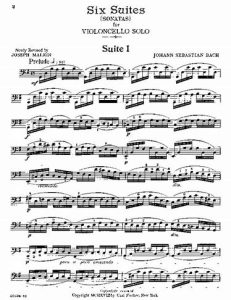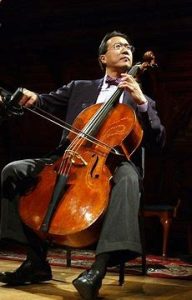
A soft, blue velvet regaled The Los Angeles night. The concentric circles of the Hollywood Bowl’s procenium glowed with a warm, eggshell white. White-jacketed waiters served last suppers on trays and scuttled away. Onstage, two microphones bracketed a single, straight-backed chair. Without announcement, a man in white tie and tails walked from stage right, carrying a cello burnished by age and a rich orange-red hue.
The lights dimmed and the concave shell of the Bowl changed to the same blue velvet as the color of the Angeleno sky. The man sat down, placed the instrument between his knees, and smiled at the amphitheater’s masses. He placed the bow on the strings, took a breath, and began the first notes of the first movement of Bach’s Cello Suite #1 in G major.
 For two hours and 40 minutes, the Hollywood Bowl reverberated to the arpeggios, octaves, and double stops of Bach’s baroque homage to this perfect instrument. The tiny man played on through the intricacies of each suite’s preludes, allemandes, courantes, sarabandes, bourrées, and gigues. When he finished each composition, he launched into the next.
For two hours and 40 minutes, the Hollywood Bowl reverberated to the arpeggios, octaves, and double stops of Bach’s baroque homage to this perfect instrument. The tiny man played on through the intricacies of each suite’s preludes, allemandes, courantes, sarabandes, bourrées, and gigues. When he finished each composition, he launched into the next.
The cello’s rich sound, meticulously amplified, flowed out of the bowl and into the sky. I became aware of layer after layer of impressions — the diminutive figure’s exertions with bow and digits on the ebony fingerboard; the complex timbre and overtones of the instrument; the shape of the sound that rippled out of the layered arcs of the Bowl’s shell; the shower of notes falling onto the placid surface of the warm night; the musician’s synapses sparking with memory and tactile application.
 Bach’s cello suites are arranged in order of difficulty, the first being the simplest, continuing through over two hours of notation to the most complex. As he traversed this experimental composition — Bach had rarely written for solo stringed instruments — I became aware of a larger reality: I could trace the sounds of the suites backward, from the vibration of the instrument: the strings oscillating the bridge, which, in turn, vibrated the soundboard, passing through the unseen sound peg placed beneath one foot of the bridge between front soundboard and the cello’s back. I followed the sound into the player’s movements along the neck, where Ma’s fingers altered the resonating length of each string, set in motion by the horsehair bow. From these touch points, I followed his fingers backward through the tendons to the shoulders, each moving independently in their contrary tasks, the strong, smooth sweeps of the bow, the muscular attack of fingers on strings.
Bach’s cello suites are arranged in order of difficulty, the first being the simplest, continuing through over two hours of notation to the most complex. As he traversed this experimental composition — Bach had rarely written for solo stringed instruments — I became aware of a larger reality: I could trace the sounds of the suites backward, from the vibration of the instrument: the strings oscillating the bridge, which, in turn, vibrated the soundboard, passing through the unseen sound peg placed beneath one foot of the bridge between front soundboard and the cello’s back. I followed the sound into the player’s movements along the neck, where Ma’s fingers altered the resonating length of each string, set in motion by the horsehair bow. From these touch points, I followed his fingers backward through the tendons to the shoulders, each moving independently in their contrary tasks, the strong, smooth sweeps of the bow, the muscular attack of fingers on strings.
I felt the flow of impulses from Yo Yo’s right auditory cortex upward through the top of his skull and into the cosmos where elapsed time disappeared, and Ma’s movements connected to the cerebral energy of the old composer who sat, meticulously present through three hundred irrelevant years of calibrated time. Yo Yo Ma’s boundless energy (he began to tire slightly in the sixth and final suite), radiated the cascading arpeggios of Bach’s composition through the fragile endurance of the Stradivarius instrument, older than the Suites themselves. My senses began to swirl around the focal point of the single man, alone with the rich, red instrument, a unity of precision and love, given to us all beneath the vast, blue arc of the Hollywood Bowl. I suppose I sat as close to my own, weird god as I ever come.
# # #
Writer, editor, and educator based in Los Angeles. He's also played a lot of music. Degelman teaches writing at California State University, Los Angeles.
Degelman lives in the hills of Hollywood with his companion on the road of life, four cats, assorted dogs, and a coterie of communard brothers and sisters.



Thanx for your lovely story Charles.
We saw Yo-Yo Ma live only once and altho not classical music savvy, I knew I was witnessing something pretty special.
My dad however was a self-taught classical pianist and had busts of Chopin and Beethoven
on his baby grand. Like Bach listening to Ma with you at the Hollywood Bowl, I’ll now think of my dad’s two favorite composers listening to him!
I bet they were all ears! Of course Beethoven wouldn’t have been able to hear him, but who’s keeping track!
What at transformational experience, so beautifully told! It sounds like an epic performance/experience, enhanced by your musical knowledge. I probably would have just enjoyed it without the depth of understanding, but you are lucky to bring so much with you to appreciate the music. Thanks for sharing it.
Thanks, Khati! Yeah, I’m sure there was plenty to enjoy without knowing what a sound peg is. 🙂
These words are transportation: I was taken back to the concert but the writer’s description was so filled with an artist’s understanding of every aspect of music, that I realized how little I know! In a great way my memory was brought back to me with insights I wished I had myself. Luckily, they get to read this deeply detailed sharing. Beautiful.
Thanks, Susan!
You have added a dimension of musical understanding to your experience (and to mine) in seeing and hearing Yo-Yo Ma. Stanford’s Memorial Auditorium was a grand place to hear him play such music, but the atmospherics of the Hollywood Bowl takes it to a higher and deeper level. Thanks for validating my impressions of what I saw and heard so many years ago.
Thanks, Marian. I was amazed at the quality of sound at the Bowl. Recording a complex-toned solo instrument in such a wide-open space was quite a feat. It was also astounded at the energy and focus it took to play solo and fill that space with just Yo Yo and Johann… with a little help from Stradivarius and the sound guy.
Wow, that must have been incredible! Your featured image speaks volumes – one man, one cello in that vast space with the diamond sky overhead. And I note that there is no music stand, so he played from memory for two hours and forty minutes! Awe-inspiring, in the true meaning of the phrase. You capture it brilliantly with your writing!
Thanks, Suzy. It was a performance to remember, among many (including some even my own). And as a musician, you can appreciate that he had committed to memory (probably long ago), two hours and forty minutes of dense arpeggios. Imagine!
Your own story is a tour de force describing every layered detail of the evening, from the stars to Ma’s energy flagging a bit in the final suite. Yet through his incandescent playing on his old instrument of Bach’s Baroque music, how he connected through time and space across to everything relevant and brought that experience to you, his avid listener. We could feel it too, Charles.
My chorus will be returning in a few weeks. It will be the first time I’ve sung since we shut down in mid-March, 2020. We will be singing Bach too, (I’m not sure what exactly, but the theme is “Bach is Back”). I can’t wait to rejoin that universe.
Thanks, Betsy! A chorus offers a wonderful opportunity to offer up joy to the world!
Beautiful description of an amazing performer.
Transcendent… Transcendental… Me, Yo Yo, ol’ Calvinist Johann, and Henry David Thoreau all hangin’ out at Hollywood’s Walden Pond, groovin’. 😎